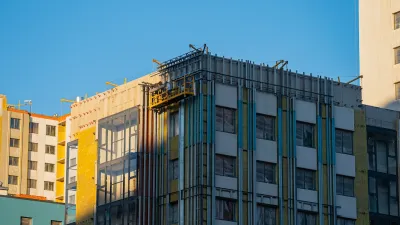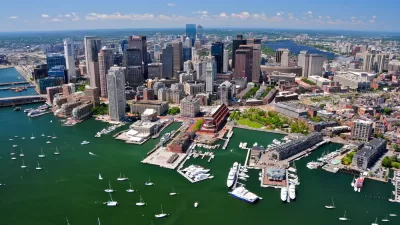The energy costs of big houses on big lots overshadow the benefits of energy efficiency.
As we have reported here before, the built environment is the single largest consumer of materials, and these energy expenditures account for 42 percent of all greenhouse gasses emitted in the United States.
Even though "energy efficiency" has become a very popular consumer product since the environmental movement of the 1970s took off, American single-family houses have doubled in size since then, and they are full of much more energy-sapping stuff.
"Energy intensity, or the units of energy expended per household, has actually increased since the early 1980s, with the average home using 183 million British thermal units (Btu) in 1981 and 188.7 million in 2011," reports Aarian Marshall.
Where there was once one TV in one modest living room, there are now many TVs in many rooms. Add to that laptops, robots, sound systems, security systems, heating and cooling systems and the myriad kitchen appliances and handy gadgets that accommodate modern life: it’s a lot of energy-hungry stuff.
Apartments and mobile homes, however, have made modest but significant declines in overall energy consumption. Since 1970, apartments with 2-5 units have decreased energy usage by five percent; apartments with five or more units have slashed 12 percent; and mobile home consumption is down eight percent.
Marshall warns: "Many Americans may still want a single-family home in the suburbs, but that’s not the path to an energy efficient future."
FULL STORY: America’s Increasingly Large Homes Are Making Us Less Energy Efficient

Planetizen Federal Action Tracker
A weekly monitor of how Trump’s orders and actions are impacting planners and planning in America.

Map: Where Senate Republicans Want to Sell Your Public Lands
For public land advocates, the Senate Republicans’ proposal to sell millions of acres of public land in the West is “the biggest fight of their careers.”

Restaurant Patios Were a Pandemic Win — Why Were They so Hard to Keep?
Social distancing requirements and changes in travel patterns prompted cities to pilot new uses for street and sidewalk space. Then it got complicated.

Platform Pilsner: Vancouver Transit Agency Releases... a Beer?
TransLink will receive a portion of every sale of the four-pack.

Toronto Weighs Cheaper Transit, Parking Hikes for Major Events
Special event rates would take effect during large festivals, sports games and concerts to ‘discourage driving, manage congestion and free up space for transit.”

Berlin to Consider Car-Free Zone Larger Than Manhattan
The area bound by the 22-mile Ringbahn would still allow 12 uses of a private automobile per year per person, and several other exemptions.
Urban Design for Planners 1: Software Tools
This six-course series explores essential urban design concepts using open source software and equips planners with the tools they need to participate fully in the urban design process.
Planning for Universal Design
Learn the tools for implementing Universal Design in planning regulations.
Heyer Gruel & Associates PA
JM Goldson LLC
Custer County Colorado
City of Camden Redevelopment Agency
City of Astoria
Transportation Research & Education Center (TREC) at Portland State University
Camden Redevelopment Agency
City of Claremont
Municipality of Princeton (NJ)





























